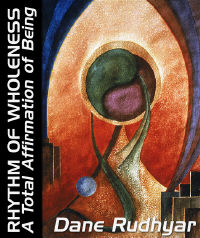 |
| Home | Bio | Art | Music | Literature | Civilization & Culture | Philosophy of Wholeness | Theosophy & Spirituality | Astrology |

RHYTHM OF WHOLENESS A Total Affirmation of Being by Dane Rudhyar, 1983 CONTENTS PROLOGUE PART ONE The Philosophy of Operative Wholeness 1. Prelude to a New Interpretation of Reality Page 1 Page 2 Page 3 Page 4 Page 5 Page 6 2. The Search for Spiritual Security: The One, the Whole, and Wholeness 3. The Movement of Wholeness PART TWO The Cycle of Being 4. The Structure of the Cycle of Being 5. The Four Crucial Phases of the Cycle of Being 6. The Inevitability of Success and Failure 7. Spirit and Mind PART THREE The Cycle of Man 8. Constitution of Man - The Physical and Psychic Bodies 9. Constitution of Man - The Spiritual Entity and the Higher Mind 10. The Structure and Transformation of the Total Person 11. The Cyclic Process of Spiritual Embodiment PART FOUR In The Spirit of Wholeness 12. The Principle of Holarchy and the Interplay of Horizontal and Vertical Relationships 13. Transpersonal Activity versus Mediumship 14. Rites of Passage EPILOGUE |

CHAPTER ONE
Prelude to a New Interpretation of Reality - 2 The animistic approach: At this stage of the evolution of human consciousness, the level of interpretation on which knowledge is based is almost exclusively biological. The interpretation is dominated by the basic need for survival. Also included is the need for biological expansion in order to increase a sense of security and relaxation, which is particularly valuable for the education of progeny requiring a relatively long time to mature. To survive means to deal successfully with the unceasing challenges presented by an inimical biosphere. Many of these challenges recur; repetition reveals their distinct characters and quasi-permanent features. Primitive peoples infer that these recurring, recognizable challenges are produced by "entities." Being distinct, the entities are given names derived from the experiences with which they are identified. These entities are "spirits"; they have to be overcome or controlled by force or cunning, or they have to be propitiated by gifts they are believed to enjoy, i.e. sacrifices.(2) Primitive man designates as a spirit every entity that periodically or even unpredictably changes while nevertheless retaining its form or characteristic features. Other human beings are also spirits as long as they move and, especially, breathe. Death occurs when the spirit leaves the material body, which then decays. Animistic cults regulate the relationships human beings should have with the many spirits operating in their environment, which includes visible and invisible factors, aspects that can be defined ("named") and manipulated, and more imprecise ones that cannot. Relationships with spirits are formalized into rituals and, magical operations. Some human beings, both men and women, demonstrate special abilities to deal with spirits. They are shamans and medicine men. At this stage of human evolution, one should speak of cults rather than religions; but the transition from the former to the latter is never clearly marked. Neither is the transition from the evident pluralism of primitive cults to the dualism of the new type of systems of interpretation called vitalism. The pluralism of the animistic stage of consciousness and activity is grounded, as it were, in the awareness — implicit if not clearly explicit and formulated — of the specific quality of the environment in which human beings meet these many spirits. An at least rudimentary ecological consciousness provides a limiting background for dealing with these spirits. However, this background acquires a basically new character when a vitalistic approach is formulated and codified in symbols and myths. The local environment — the forest, the pampas, the mountain valley — is then universalized into a measureless "ocean of life," the "One Life," or a vast cosmic organism, "the Whole." The vitalistic approach: A vitalistic approach to repetitive events with a clearly periodical and seasonal character develops when agriculture and animal husbandry come to dominate the lives of at least the most advanced groups of human beings. Such groups operate in increasingly large tribes which are almost totally dominated by biological activities and a symbolic kind of consciousness. Agriculture and animal husbandry are based upon the collectively experienced power of multiplication inherent in certain kinds of natural entities. This capacity for multiplication is called life. It is a potency added to the ability to move and change form, the ability which characterizes spirits. In plants this life potency can be assisted and to some extent controlled by human beings through cultivation — and in the case of animals, through domestication and supervised breeding. Life's multiplication operates through the union of two kinds of specialized genital organs — phallus and yoni and their equivalents in nonhuman species. Therefore, the realization of a basic dualism at work in most types of living entities becomes the fundamental answer to the need of the group. This dualism is, however, functional. The condition of life is not merely a background for the interaction of two kinds of entities; life itself acts in and through the polarization of its energy in sexually differentiated entities. Life is the substratum of all there is. It is present everywhere in one mode of operation or another. In its most mysterious form it is the process of multiplication. This mystery is still at the root of the Catholic tradition. It is expressed in the Gospel story of the multiplication of loaves of bread and fish to feed the multitude, raised to a "higher" level of understanding by Jesus' teachings. In a more transcendent (metabiological and mystical) form it occurs in the great mythos of the Eucharist — the quasi-infinite, ritualistic multiplication of the "divine seed" — Christ. When consecrated and transubstantiated, the white circular Host symbolizes the "God seed," the potentiality inherent in every newborn infant to actualize the archetype Man, which is considered a reflection of the one God, the Divine Person. The biological foundation of the vitalistic approach is spiritualized (that is, universalized) and transformed in this great mythos. The purpose (unconscious if not conscious) of its originators must have been to catalyze this transformation. The sacramental transubstantiation of the Host links the biological level of strictly physical bodily existence with a "higher" state of evolution interpreted as God's reign on earth, which seemingly will develop only in the future. I call this state the Pleroma level of evolution, and I shall define its essential character in terms of a relatively new model of evolution. According to this model, the individualism dominating human consciousness and activities today constitutes an intermediary stage of evolution between the vitalistic approach to reality and a higher mode of being (that is, of consciousness and activity), the Pleroma state.(3) So does the concurrently developing, equally dominant quantitative mind, which operates on the basis of measurements and through the discovery and manipulation of "laws" establishing precisely defined relationships between entities believed to be inherently separate. Mankind as a whole is now passing through this intermediary stage. However, the consciousness, the desires, and the dominant type of activity of the vast majority of human beings are still rooted in and usually controlled by biological processes or by movements and beliefs which translate these processes to the level of psychic activity and social feeling-responses. In other words, in extremely diverse ways most people are experiencing the process of individualization of their vitalistic nature. This process leads to a mentalization of consciousness in which "reason" takes the place of "life" as a determining (or at least conditioning) factor. Mentalization, in turn, gives a definite form and power to the drive toward asserting and even glorifying individual selfhood; but the substance or energy condensed, concentrated, and given a precise form and name by the concretizing mind usually remains the substance-energy of "life," even though it may be translated in terms "of the cultural paradigms and the "classical" scientific spirit of Western civilization. 2. In much the same manner, an infant makes entities of repetitive groups of sensations and feelings — not only parents, siblings, nurse, dog, but also cradle, table, and the light- or darkness-producing objects which eventually acquire permanent characters through being named. Return 3. In widely read and highly praised books, Ken Wilber apparently follows the example of the Jungian psychologist Erich Neumann, and has used the word pleroma to characterize an undifferentiated and preconscious condition of being — the primordial "ground" out of which human consciousness arises at the beginning of its evolution. This is not the true meaning of this ancient Greek term, which always has referred to a state of fullness and fulfillment, usually in a spiritual and divine sense. It is not the meaning the word had among the Gnostic groups of the first centuries. Webster's New International Dictionary (Second Edition) defines pleroma as "the fullness of divine excellences and powers (see Ephesians III, 19; Col. 1, 19, II, 9) and in Gnosticism the fullness of being of the divine life, comprising the aeons as well as the uncreated monad (or, according to some, dyad) from which they have proceeded." A footnote in C. G. Jung's Aion (Princeton University Press, 1959, p. 41n) reads: Irenaeus (Adversus haersus, II, 5, 1) records the Gnostic teaching that when Christ, as the demiurgic Logos, created his mother's being, he "cast her out of the Pleroma — that is, he cut her off from knowledge." For creation took place outside the pleroma, in the shadow and the void. According to Valentinus (Adv. haer., I, II, 1), Christ did not spring from the Aeons of the pleroma, but from the mother who was outside it. She bore him, he says, "not without a kind of shadow." But he, "being masculine," cast off the shadow from himself and returned to the Pleroma..., while his mother, "being left behind in the shadow, and deprived of spiritual substance, there gave birth to the real "Demiurge and Pantokrator of the lower world." But the shadow which lies over the world is, as we know from the Gospels, the princeps huius mundi, the devil. Cf. The Writings of Irenaeus, I, pp. 45f. Return By permission of Leyla Rudhyar Hill Copyright © 1983 by Dane Rudhyar All Rights Reserved.  Web design and all data, text and graphics appearing on this site are protected by US and International Copyright and are not to be reproduced, distributed, circulated, offered for sale, or given away, in any form, by any means, electronic or conventional. See Notices for full copyright statement and conditions of use. Web design copyright © 2000-2004 by Michael R. Meyer. All Rights Reserved. |
 |